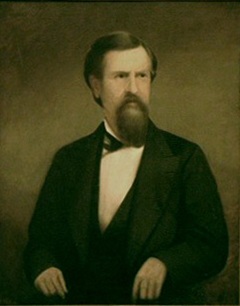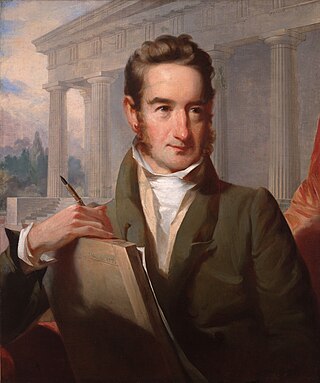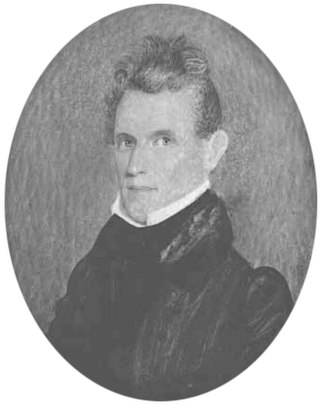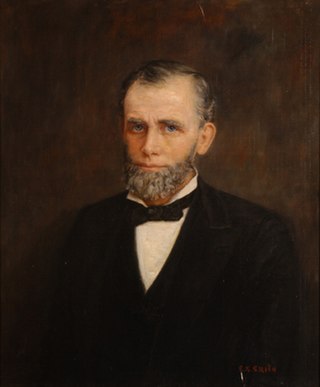Related Research Articles

Neill Smith Brown was an American politician and diplomat who served as the 12th Governor of Tennessee from 1847 to 1849, and as the United States Minister to Russia from 1850 to 1853. He also served several terms in the Tennessee House of Representatives, and was Speaker of the House for the 1855–1857 term. A lifelong Whig, Brown campaigned to keep Tennessee in the Union in the years leading up to the Civil War. However, once the war began, he sided with the Confederacy.

James Davis Porter was an American attorney, politician, educator, and officer of the Confederate Army. He served as the 20th Governor of Tennessee from 1875 to 1879. He was subsequently appointed as Assistant Secretary of State during President Grover Cleveland's first administration, and Minister to Chile in Cleveland's second administration.

Robert Love Taylor was an American politician, writer, and lecturer. A member of the Democratic Party, he served three terms as the 24th governor of Tennessee, from 1887 to 1891, and again from 1897 to 1899, and subsequently served as a United States senator from 1907 until his death. He also represented Tennessee's 1st district in the United States House of Representatives from 1879 to 1881, the last Democrat to hold the district's seat.

Andrew Jackson Donelson was an American diplomat and politician. He served in various positions as a Democrat and was the Know Nothing nominee for US vice president in 1856.

William Strickland was a noted architect and civil engineer in Philadelphia, Pennsylvania, and Nashville, Tennessee. A student of Benjamin Latrobe and mentor to Thomas Ustick Walter, Strickland helped establish the Greek Revival movement in the United States. A pioneering engineer, he wrote a seminal book on railroad construction, helped build several early American railroads, and designed the first ocean breakwater in the Western Hemisphere. He was elected as a member of the American Philosophical Society in 1820.

George Campbell Childress was a lawyer, politician, and a principal author of the Texas Declaration of Independence.
University of Nashville was a private university in Nashville, Tennessee. It was established in 1806 as Cumberland College. It existed as a distinct entity until 1909; operating at various times a medical school, a four-year military college, a literary arts college, and a boys preparatory school. Educational institutions in operation today that can trace their roots to the University of Nashville include Montgomery Bell Academy, an all-male preparatory school; the Vanderbilt University Medical School; Peabody College at Vanderbilt University; and the University School of Nashville, a co-educational preparatory school.
Balie Peyton was an American lawyer and politician who represented Tennessee's 6th congressional district in the United States House of Representatives.

George Washington Barrow was a slave owner, American politician, a member of the United States House of Representatives for Tennessee's 8th congressional district; he later fought against the Union as a member of the Confederate Army and was charged with treason.

The Nashville Convention was a political meeting held in Nashville, Tennessee, on June 3–11, 1850. Delegates from nine slave states met to consider secession, if the United States Congress decided to ban slavery in the new territories being added to the country as a result of the Louisiana Purchase and the Mexican–American War. The compromises worked out in Nashville paved the way for the Compromise of 1850, including the Fugitive Slave Act of 1850, and for a time, preserved the union of the United States.

Landon Carter Haynes was an American politician who served as a Confederate States senator from Tennessee from 1862 to 1865. He also served several terms in the Tennessee House of Representatives, including one term as speaker (1849–1851). In the early 1840s, Haynes worked as editor of the Jonesborough-based newspaper, Tennessee Sentinel, garnering regional fame for his frequent clashes with rival editor, William "Parson" Brownlow.
The Louisville and Nashville Turnpike was a toll road that ran from Louisville, Kentucky to Nashville, Tennessee during the 19th century. From Louisville, one route now designated US 31W ran through Elizabethtown, Munfordville, Glasgow Junction, Bowling Green, and Franklin before crossing into Tennessee. In Tennessee, the route would continue through Portland, Cross Plains, Millersville and Goodlettsville before going into Nashville. The other route ran through Bardstown, Buffalo, Glasgow, and Scottsville and is currently named US 31E. The name survives in abbreviated form along routes including Kentucky State Routes 335 and 470. US 31W is usually named for the Dixie Highway which succeeded the Turnpike.

Anne Dallas Dudley was an American activist in the women's suffrage movement. She was a national and state leader in the fight for women's suffrage who worked to secure the ratification of the 19th Amendment in Tennessee.
Albert Smiley Williams (1849–1924) was an American Democratic politician. He served as the Mayor of Nashville, Tennessee, from 1904 to 1906.

Washington Bogart Cooper was an American portrait painter, sometimes known as "the man of a thousand portraits".

John McCormick Lea was an American Whig politician. He served as the Mayor of Nashville, Tennessee from 1849 to 1850.

Nathaniel Thomas Lupton was an American chemist and university professor. He served as the President of the University of Alabama from 1871 to 1874. Additionally, he served as State Chemist of Alabama.

Philip Lindsley (1786–1855) was an American Presbyterian minister, educator and classicist. He served as the acting president of the College of New Jersey from 1822 to 1824, and as the first president of the now-defunct University of Nashville from 1824 to 1850.

Judge Thomas Jefferson Latham was an American lawyer and businessman. Growing up in rural Weakley County, Tennessee, in the Antebellum South, he became a lawyer and remained neutral during the American Civil War. In the post-bellum era, he served as the debt receiver of the City of Memphis, Tennessee, and the president of the Memphis Water Company. He was an investor in land development in Tennessee and coal mining in Alabama. By the time of his death, he was a millionaire.
References
- ↑ Moore, Mrs John Trotwood (September 1944). "The Tennessee Historical Society, 1849-1918". Tennessee Historical Quarterly. 3 (3): 195–225. JSTOR 42621729.
- ↑ "Cross, Nathaniel". Nashville City Cemetery . Retrieved November 16, 2017.